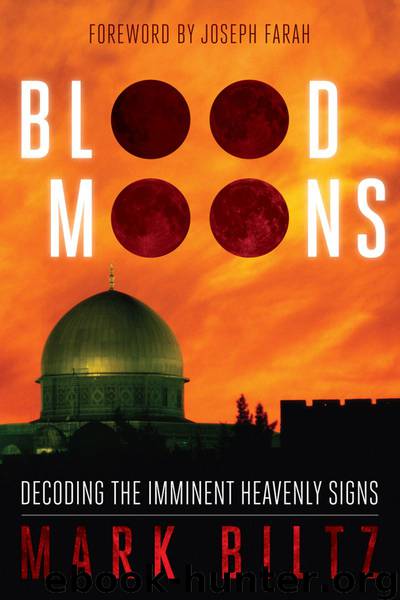Blood Moons: Decoding the Imminent Heavenly Signs by Biltz Mark

Author:Biltz, Mark [Biltz, Mark]
Language: eng
Format: epub
Publisher: WND Books
Published: 2014-03-18T00:00:00+00:00
Yom Kippur (Day of Atonement)
Yom Kippur is the holiest day of the year. It was actually known in biblical times as Yom Kippurim, which is in the plural, as there were several atonements that had to be made, as seen in Leviticus 16:33: “And he shall make an atonement for the holy sanctuary, and he shall make an atonement for the tabernacle of the congregation, and for the altar, and he shall make an atonement for the priests, and for all the people of the congregation.”
The passage goes on to tell how Aaron would cast lots for two goats. (It was always a good sign when the lot—a coin or type of dice—for the Lord turned up in the right hand of the priest.) The two goats combined made up one offering. One would be sacrificed to the Lord, and the other would become the scapegoat, to be taken out to the Judean wilderness and eventually tossed over a cliff. A scarlet thread was tied around one of the goat’s horns, and another tied to the Temple door. If the scarlet thread on the Temple door turned white, the people knew their sins were forgiven.
The Day of Atonement was to be on the tenth day of the seventh month, when all the Israelites were to have a holy dress rehearsal and afflict their souls. It was the most solemn day of the year and was considered a Sabbath of rest. The people would fast for twenty-five hours. When we understand this Jewish custom, we realize that in Acts 27:9, where we are told that “sailing was now dangerous, because the fast was now already past,” the “fast” Luke referred to was Yom Kippur.
So what happened on the first Yom Kippur after the Israelites left Egypt? In Exodus 32, we read that after Aaron made the golden calf, Moses went up to the mount and fasted for forty days. Historically, he came down on Yom Kippur with the good news that atonement had been made and God wanted to tabernacle among them. That is when they gathered all the material to begin building the tabernacle—at the Feast of Tabernacles! On this holiest day of the year, we have the holiest man (the high priest) going into the holiest place on earth (the holy of holies) to proclaim the holiest name (YHWH).
The whole concept of Yom Kippur was to take away sins. (Of course, at the time, it was the sin of the nation of Israel, not of the Gentiles, that was to be atoned for.) In Psalms 103:12, we are told how far away God wants to cast our sins from us: “as far as the east is from the west.” Note that he didn’t say as far as north is from the south because when you go south long enough, you eventually start going north again, but when you go east, you always go east. This was the day the nation of Israel was to be atoned for. It was not meant for the Gentiles.
Download
This site does not store any files on its server. We only index and link to content provided by other sites. Please contact the content providers to delete copyright contents if any and email us, we'll remove relevant links or contents immediately.
The Five People You Meet in Heaven by Mitch Albom(3476)
The Secret Power of Speaking God's Word by Joyce Meyer(2981)
Real Sex by Lauren F. Winner(2968)
Name Book, The: Over 10,000 Names--Their Meanings, Origins, and Spiritual Significance by Astoria Dorothy(2940)
The Holy Spirit by Billy Graham(2894)
0041152001443424520 .pdf by Unknown(2785)
ESV Study Bible by Crossway(2733)
How The Mind Works by Steven Pinker(2732)
Ancient Worlds by Michael Scott(2627)
Churchill by Paul Johnson(2510)
The Meaning of the Library by unknow(2508)
The ESV Study Bible by Crossway Bibles(2504)
The Gnostic Gospels by Pagels Elaine(2472)
MOSES THE EGYPTIAN by Jan Assmann(2374)
Jesus by Paul Johnson(2312)
City of Stairs by Robert Jackson Bennett(2309)
The Complete Dead Sea Scrolls in English (7th Edition) (Penguin Classics) by Geza Vermes(2237)
Ancient Near Eastern Thought and the Old Testament by John H. Walton(2196)
The Nativity by Geza Vermes(2181)
